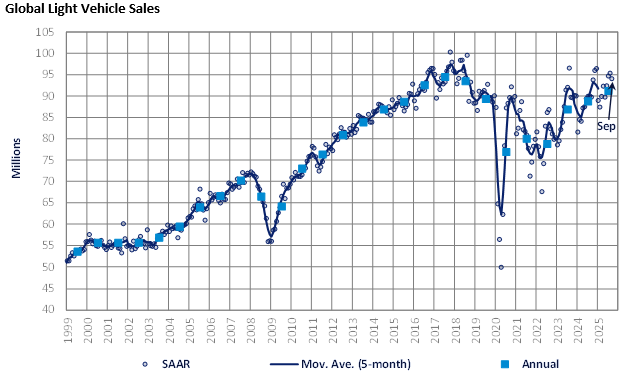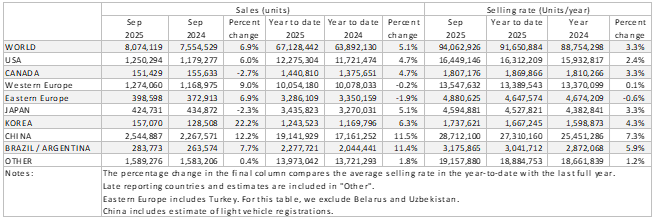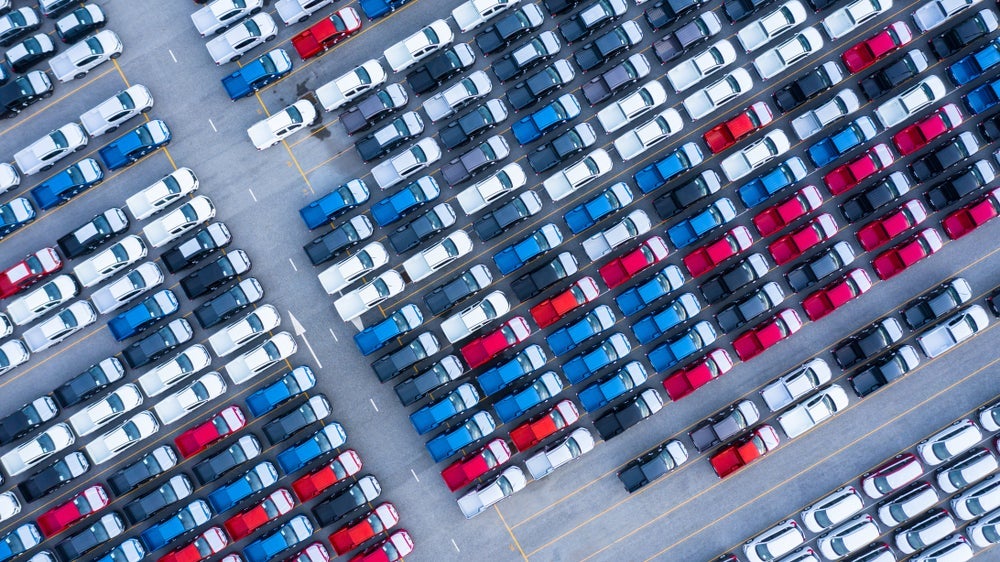For September, the Global Light Vehicle (LV) selling rate remained broadly in line with July and August, standing at 94 million units/year. In year-on-year (YoY) terms, the market grew 7% as sales reached 8.1 million units globally. Year-to-date (YTD), 67 million vehicles have been sold, up 5% from the same period in 2024.

The key markets of the US, Western Europe, and China all experienced growth driven by various factors. In the US, the surge was largely attributed to advanced EV purchases ahead of the tax credit deadline, though non-EVs also performed well as manufacturers absorbed tariff costs, mitigating price increases. In Western Europe, countries like the UK, Spain, and Germany enjoyed YoY growth, despite it being a tough year for the region. Meanwhile, in China, ongoing government support and the lasting effects of the price war continued to drive strong EV sales.

North America
US Light Vehicle sales grew by 6% YoY in September, to 1.25 million units, supported by an additional selling day. The annualized selling rate accelerated to 16.4 million units/year in September, slightly up on the August result. Some of September’s strength was derived from pulled-forward EV sales, as federal tax credits ceased at the end of the month. However, even non-EVs performed well, as OEMs absorbed tariff costs, limiting the impact on pricing for most mainstream brands. Average transaction prices were US$45,927 in August, up by US$933 MoM, while incentives averaged US$3,214 in September, up by US$121 MoM.
Canadian Light Vehicle sales totaled an estimated 151k units in September, down by 2.7% YoY, while the selling rate slowed marginally, to 1.81 million units/year, from 1.82 million units/year in August. Increasing cost pressures from tariffs are slowly starting to be reflected in pricing, but the fact that price hikes have been limited so far has kept sales flowing despite challenging conditions. In Mexico, sales grew by 4.1% YoY, to 126k units. The selling rate slowed to 1.59 million units/year, from 1.65 million units/year in August, but this was still the second-strongest September on record in volume terms.
Europe

US Tariffs are shifting - will you react or anticipate?
Don’t let policy changes catch you off guard. Stay proactive with real-time data and expert analysis.
By GlobalDataThe Western Europe LV market grew 9% YoY in September as sales grew to nearly 1.3 million units. The monthly selling rate dropped 9% to 13.5 million units/year. YTD sales remain broadly flat at 10.1 million units, down fractionally from the same period last year. Across the region’s five major markets, all experienced growth for the first time in many months. Spain continued to shine as the standout performer, while both Germany and the UK demonstrated strong growth, both attributed to a weak base and assisted by government incentives.
In Eastern Europe, the LV selling rate for September was 4.9 million units/year, continuing the growth seen in August. The Russian LV market fell 12% YoY in September, compared to -18% YoY in the first nine months of 2025. Sales this year have been undermined by the country’s high base rate and increases to the vehicle recycling fee, which have squeezed auto financing and reduced foreign car imports respectively. The Turkish PV market grew for a sixth consecutive month as sales were up nearly 27% YoY in September, totaling 88k units.
China
The China market’s PV for September came in at 2.32 million units in a month of 11% YoY expansion. The wholesale export-included measure set a record high for the month of September. With exports excluded, the selling rate came in at 28.7 million units/year, leaving the Q3 average just below 30mn. The continuing effects of the market’s price war still drive sales as consumers face very competitive prices at the dealership, month after month. Meanwhile, Chinese government support including the trade-in incentive scheme, continues to boost sales.
The near-term outlook for the PV market takes into account the Chinese government recently outlining its intention to continue promoting automobile consumption— we assume the trade-in incentive programme will now run through 2026. This means more consumers will pull forward purchasing decisions into late 2026, from of later years, though there is no explicit news on the end date of its support. At this stage, 2027 looks set to see a significant slowdown in market pace.
Japan’s September sales fell 2.3% YoY to 420k units, which leaves Q3’s YoY growth at -4%. H1 2025 saw some strong momentum (despite some fluctuation in Q1 due to the Chuo Spring plant issue) though this strength has now lost steam, and selling rates are lower as a result. High vehicle loan repayment rates are pressuring consumers’ finances after the BoJ raised interest rates last year.
In Korea, sales jumped 22% YoY to 157k units for September. The surge is heavily driven by the extra selling days this September due to the timing of the Chuseok holidays, which instead fall in October this year. There was also some material strength however, in the form of new model releases from Hyundai and Kia, the country’s biggest automakers. In selling rate terms, the market had its second highest month, just behind the previous month, leaving Q3 the strongest quarter of the year on a seasonally adjusted basis.
South America
Brazilian Light Vehicle sales totaled 231k units in September, up by 4.0% YoY. The selling rate accelerated to 2.60 million units/year in September, from 2.44 million units/year in August. This was the strongest selling rate of the year to date, with fleet sales appearing to play a major part in supporting total volumes. While there is some evidence that reductions to the IPI tax on certain domestic models with a 1.0 litre engine might be boosting sales of those specific trims, it also appears that other versions of the same models with larger engines may be losing out as a result.
In Argentina, sales continued to grow robustly, with volumes totalling 53.0k units, up by 29.1% YoY. The selling rate ticked up to 585k units/year in September, from 557k units/year in August. For now, the opening up of the Argentine vehicle market to imported models, along with tax reductions, are outweighing any drag from growing concerns over the state of the economy.

This article was first published on GlobalData’s dedicated research platform, the Automotive Intelligence Center.





